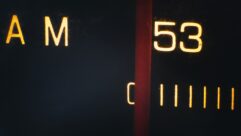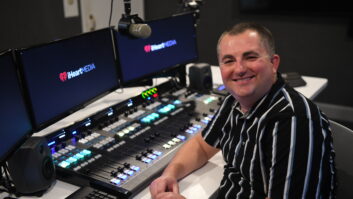
Rohde & Schwarz’s transmitter plant in Teisnach, Germany Readers who have followed my RF Technology column for the last 20 years may have noticed that I started out saying that solid-state amplifiers would have a hard time competing with tube amplifiers in high power applications. Over the years, usually after the NAB Show, I gradually upped the output power at which I thought solid-state amplifiers made sense.
Solid-state amplifiers won the battle at VHF before the DTV transition started. The Harris Platinum transmitter, with its drawers of amplifiers, along with transmitters from Larcan such as the Magnum, were the winners in that battle.
DOHERTY AMPLIFIERS CATCHING UP
The use of 50-Volt LDMOS amplifiers in transmitters such as the Harris Maxiva ULX allow for ATSC output power of more than 40 kW at efficiencies similar to those for standard IOT transmitters but less than that possible with transmitters such as the Comark Paragon that use multiple- stage-depressed-collector (MSDC) IOT devices from L-3. Solidstate Doherty amplifiers, as I explained in my June 2012 RF Technology column (“Coming: Higher Efficiency for Higher Power Amplifiers”), can now approach the plant efficiency of MSDC-IOT amplifiers.
Based on what I’ve seen at the Rohde and Schwarz plant in Teisnach in Germany and the performance of the two R&S THU9 Doherty solid-state transmitters I had the opportunity to work with last year, I think the THU9 could do for solid-state UHF TV transmission what the Harris Platinum did for solid-state VHF transmission over a decade ago.

Fig. 1: The back of a Rohde & Schwarz THU9 amplifier cabinet. Note the lack of RF cables. All R&S transmitters are manufactured at the Teisnach plant, using assemblies made there or at one of the other R&S facilities in Germany. The Teisnach plant houses CNC machines and other tooling to crank out enclosures and precisely mill the RF combiners used in the THU9 as well as filters and couplers that work into the millimeter band. The plant includes facilities for making printed circuit boards and also for assembling the transmitters. The same basic cabinet design is used for different analog and digital modulation standards, starting at the low-end of the FM band to beyond the UHF TV band.
Some of the design engineering that went into the THU9 can be seen in Fig. 1, showing the back of a THU9 amplifier cabinet. Note the lack of RF cables. The amplifiers plug directly into the combiner (the bright aluminum piece extending up from the bottom of the cabinet). The output of that combiner is combined with the output of the second amplifier (4-inch copper line) in a second combiner for output to the mask filter (for powers up to 25 kW) or to a final combiner, (for powers up to 50 kW). The red cylinder in the stack is the low-power filter for the amplifier; an external low-pass filter is not required. This design minimizes cost, increases reliability and makes assembly easier. The downside is that each combiner plate is built for a specific number of amplifiers; you can’t add more later.
EASIER THAN TUBES
The THU9 transmitter installed for WWSI at the Richland Tower site near Waterford, N.J. is rated for 43 kW. Compared to a dual cabinet MSDC-IOT transmitter, the complete installation is more compact, as the photo of the front of the transmitter shows (Fig. 2). Although there are no HV beam supplies, the THU9 requires 400 VAC, so step-down transformers are required. You can see these transformers stacked behind the four redundant pump/ tank assemblies for the cooling system in Fig. 3. The pumps are so quiet that, with other noise in the building, you can’t tell whether they are on or off without looking at their status lights or the transmitter control screen.
The installation of the THU9 was relatively easy compared to a tube installation. Communication between cabinets uses the CAN bus standard, the system developed for communication between vehicle components, simplifying cabling. This transmitter was designed for redundancy, so there are two power circuits to each cabinet. In addition to a central controller, each of the two exciters has a controller that can keep the transmitter on the air at reduced power if one power circuit goes down or if the main controller or exciter fails.

Fig. 2: WWSI’s THU9 transmitter near Waterford, N.J. While it may seem that using those big green hoses to connect the pumps and heat exchangers to the cabinets is easier than soldering and fitting copper pipe, after seeing the effort required to muscle these huge green snakes into place, I’m not so sure. Each fitting has to be sealed with hemp rope and grease, a messy affair. R&S does not allow use of copper anywhere in the cooling system due to its reaction with the aluminum in the heat sinks, so copper isn’t an alternative here. I hope R&S can come up with an easier and just as reliable solution for interconnecting cooling components.
I did have the opportunity to measure the efficiency of the system, both in Germany with the transmitter under test and at the Waterford site. To make the authorized ERP, 35.74 kW was required after the mask filter, which meant the transmitter was operating about 5 kW below its maximum output capability. The plant efficiency as installed, measured by comparing the measured output average RF power out to the measured AC power feeding the entire transmitter plant (racks, pumps, heat exchangers, transmitter, monitoring, cooling fans), was better than 41 percent, while achieving an MER of just under 40 dB. If I’d been willing to accept a lower MER, efficiency would have been a bit greater. This compares to plant efficiency of just over 43 percent that I measured on a two-cabinet MSDC-IOT transmitter at around 53 kW RF out.
REAL-WORLD MEASUREMENTS

Fig. 3: At WWSI’s THU9 transmitter installation, there are no HV beam supplies, but the THU9 requires 400 VAC, so step-down transformers are needed. These transformers are stacked behind the four redundant pump/tank assemblies for the cooling system. At next week’s NAB Show, I expect transmitter salesmen to spout all manner of efficiency numbers for both solid-state and tube amplifiers. When comparing transmitters, make sure they are talking about the same thing. Total plant efficiency, which will include the power used for cooling the transmitter and all the other components required to make the transmitter put out RF, is the best measure. Looking at amplifier efficiency, IOT “beam efficiency” or LDMOS “drain efficiency” alone are not sufficient.
Measurements with real-world systems, like I did above, are best, but with the caveat that plant efficiency numbers can be skewed by plant design. For example, for redundancy, a station may decide to use a separate heat exchanger for each amplifier and perhaps even a separate one for the station load. This requires pumps and fans that draw a lot of power. That will lower that station’s plant efficiency compared with one that cools two MSDC IOT or solid-state amplifier cabinets and the dummy load with one heat exchanger.
I’m hoping to see some new, more efficient solid-state UHF amplifier designs at NAB that will give buyers more choices and help make high-power solid-state transmitters more price competitive with high-power tube transmitters. I’ll be writing about what I find!
If you have questions or want to know more about my experience with the R&S THU9, email me at [email protected].












